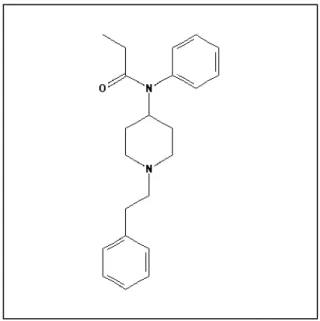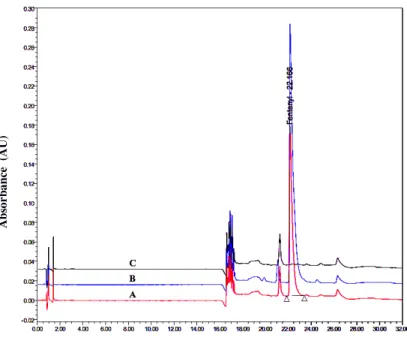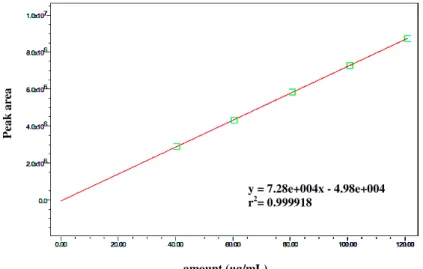1 Revista Perspectivas Online: Biológicas & Saúde Abril de 2018, Vol.8, nº 26, p. 1-8 ISSN: 2236-8868 (Online) DOI: 10.25242/886882620181240
DETERMINATION OF FENTANYL IN INJECTION SOLUTION EXPOSED TO
IMPROPER STORAGE CONDITIONS
Márcia Lombardo¹* & Jaqueline Kalleian Eserian¹
LOMBARBO, M.; & ESERIAN, J.K.; Determination of fentanyl in injection solution exposed to improper storage conditions. Perspectivas Online: Biológicas & Saúde. v. 8, n 26, p.1-8, 2018.
RESUMO
A estabilidade de medicamentos consiste no potencial do produto em preservar as especificações de qualidade em toda a cadeia de suprimento. Embora esforços devam ser realizados para aprimorar a estabilidade da formulação, algumas precauções podem ser requeridas para minimizar fatores externos que afetem características físico-químicas determinantes da eficácia e segurança do produto. Neste trabalho, uma solução injetável de citrato de fentanila foi submetida a diferentes esquemas de fotoexposição a curto prazo, a fim de simular
possíveis desvios no manuseio e armazenamento do produto durante a rotina hospitalar. O teor do fármaco foi avaliado por cromatografia líquida de alta eficiência em fase reversa (CLAE-FR), utilizando um detector de fotodiodos. Os resultados indicaram que o teor de fentanila foi satisfatório, mesmo após a exposição das ampolas à luz solar ou à luz artificial por 18 horas. Estudos futuros se fazem necessários para avaliar o efeito de condições ambientais adversas sobre a solução injetável de fentanila.
2 ABSTRACT
Stability of drugs consists of the product`s potential to preserve the quality specifications within the entire supply chain. Although efforts should be taken to improve the formulation stability, some precautions may be required to minimize external factors affecting physicochemical characteristics that determine product's effectiveness and safety. In this work, fentanyl citrate injection solution has been subjected to different schemes of short-term photoexposure, in order to simulate possible
deviations in the handling and storage of the product during the hospital routine. Drug potency was evaluated by reversed-phase high-performance liquid chromatography (RP-HPLC), using a photodiode array detector. The results indicated that the amount of fentanyl was satisfactory even after the exposure of the ampoules to sunlight or artificial light for 18 hours. Further studies are needed to evaluate the effect of adverse environmental conditions on fentanyl injection.
Keywords: Fentanyl; Drug Stability; Drug Storage.
¹
Instituto Adolfo Lutz, Centro de Medicamentos, Cosméticos e Saneantes. Avenida Doutor Arnaldo, 355, Prédio BQ, 5º andar, CEP 01246-902 - São Paulo – SP.(*)e-mail: marcia.lombardo@ial.sp.gov.br
3 1. INTRODUCTION
Fentanyl is a very potent drug substance used to improve analgesia during general anaesthesia (SANO et al., 2006). FDA-approved indications of fentanyl also include postoperative pain and breakthrough cancer pain (BORNEMANN-CIMENTI, 2013; MICROMEDEX, 2017). Fentanyl readily permeate the blood–brain barrier and have an intrinsic action at the opioid receptor, with rapid onset and short duration (BORNEMANN-CIMENTI, 2013).
Fentanyl molecule is considered labile since its chemical structure is susceptible to different degradation pathways. It was found to decompose under heat, light, acid, alkaline or oxidant conditions (LAMBROPOULOS et al.,1999; GARG et al., 2010; QI et al., 2011). N-phenyl-1-(2-phenylethyl)-piperidin-4-amine (PPA) is suggested by some authors as a potentially genotoxic degradation product of fentanyl, probably attributted to the presence of the aromatic amino group (Figure 1). PPA was designated by European Pharmacopoeia as fentanyl impurity D, among six others (GARG et al., 2010).
Figure 1: Chemical structure of fentanyl (Source: PubChem Open Chemistry Database)
The package leaflet of fentanyl injection recommends that ampoules should be stored inside the cartridge, protected from light. According to Tønnesen (2004), photolysis of drugs may occur by exposure to direct or filtered sunlight, fluorescent or incandescent artificial light. The UV component of sunlight is the most potentially damaging and while the principal output of artificial light sources is in the visible region, there is also a significant UV component. Photoreactivity is initiated by the absorption of energy, which leads to complex reactions often involving singlet oxygen.
Garg et al. (2010) demostrated that the exposure of fentanyl powder to white fluorescent light and a very intense UV radiation for 7 days was not sufficient to degrade the drug [5]. On the other hand, the previous study conducted by Lambropoulos et al. (1999) revealed a significant decrease in the drug amount and the formation of ten degradation products, including PPA, after exposure of fentanyl aqueous solution to UV chamber (254 nm), for 13 days.
4 toxic potential of related substances formed, the loss of drug potency may lead to terapeutic failures (TØNNESEN, 2004; BAJAJ et al., 2012).
Pharmaceutical products containing photosensitive drug substances should be clearly marked and appropriately stored, but in some cases the ideals are not maintained and it is worth considering whether special additives or procedures should be included (TØNNESEN, 2004).
Considering the high instability of fentanyl, especially when in water medium, this work aimed to evaluate the drug amount in ampoules containing fentanyl injection solution exposed to different light conditions, in order to simulate possible deviations in the handling and storage of the product during the hospital routine and to investigate the effect of short-term light exposition.
2. METHODS 2.1. Chemicals
Test sample was a sterile solution of fentanyl citrate 78.5 µg/mL (equivalent to fentanyl 50 µg/mL), formulated with water for injection and sodium chloride and packaged in clear glass ampoule. The reference standard was fentanyl citrate from United States Pharmacopeia. The following reagents were used: sodium chloride, sodium phosphate monobasic anhydrous, sodium phosphate dibasic anhydrous (analytical grade, Synth) and acetonitrile (gradient grade for HPLC, Puriss P.A, Vetec). All solutions were prepared with deionized water and filtered through PVDF 0.45 µm membrane (Millipore).
2.2. Instrumentation
Alliance HPLC System (Waters) equipped with separation module (e2695) and photodiode array detector (2998), desktop computer loaded with Empower 3.0 software, microbalance MT5 (Mettler Toledo), water purification system (Veolia) and ultrasonic cleaner (Unique) were used for analysis.
2.3. Photoexposure
The experimental protocol was designed to cover different conditions of fentanyl light exposure,
considering a pilot scale. Two original ampoules, one with the label and other with the sticky label removed, and a vial of sodium chloride 0.9% w/v (blank) were submitted to the light conditions, in separate schemes. Exposure to light was held in high summer (average daily temperature ranging from 22 to 33°C), between 9 a.m. and 4 p.m., for 4, 9 or 18 hours. Exposure to natural light was performed under sunlight, through the glass window, and exposure to artificial light was performed in a room with white fluorescent lamp.
2.4. Assay
Fentanyl standard stock solution at 1000 µg/mL was prepared in saline solution and dilutions were performed in order to obtain concentrations of 20; 40; 60; 80 and 100 µg/mL. Sample and standard solutions were filtrated through 0.45 µm membrane to amber vials.The analysis was performed using an analytical column (Waters Spherisorb ODS2 4.6 × 150 mm, 5 µm) at 33 ± 2ºC. As mobile phase, a mixture of phosphate buffer 10 mM pH 8.0 (A) and acetonitrile (B), at the flow rate of 1.5 mL/min for 30 minutes and the following gradient mode (A:B): 76:24 for 15 min; 40:60 for 1 min; 35:65 for 9 min and 76:24 for 5 min, with equilibrating for 2 min. Injection volume was 75 µL and detection wavelength 215 nm. A one-way between subjects ANOVA was adopted to compare the effect of light on fentanyl amount in each ampoule/light condition (p<0.05 level), using Statistica 12.0 software.
5 time (minutes) A b so rb a n ce (A U )
3. RESULTS AND DISCUSSION
Drug stability depends on factors related to pharmaceutical form, manufacturing and packaging, as well as environmental factors especially temperature, light and humidity. In order to assess the shelf-life of pharmaceutical formulations, the manufacturer must submit the product to stability studies, including different storage and transport conditions, as recommended by the regulatory guides (FDA, 2003; BRASIL, 2005).
Still, given the peculiarities of health services routines and the internal protocols of storage, preparation and drug administration, it becomes interesting to evaluate possible deviations in the quality of drugs resulting from daily practice.
Ampoules containing fentanyl injection solution maintained at optimum storage conditions showed a positive drug identity when compared with the reference standard (Figure 2).
A = Standard (fentanyl citrate); B = Sample (fentanyl citrate injection solution); C = Blank (sodium chloride solution); AU = absorbance units.
Figure 2: Overlay HPLC chromatograms of standard solution, sample solution and blank
Fentanyl assay was based on a calibration curve with correlation coefficient (r) 0.999918 (Figure 3) and resulted in 97,4% of the drug label claim, meeting the criteria recommended in the product monograph, i.e. not less than 90.0 percent and not more than 110.0 percent of the labeled amount (United States Pharmacopeia 39, 2016).
6 Figure 3: Calibration curve of fentanyl citrate
After the light exposure conditions, the product was analyzed for fentanyl amount (Table 1). Data statistical analysis revealed that there was no significant effect of the sunlight or artificial light for 4, 9 and 18 hours, in labeled and unlabeled ampoules (p = 0.43). Post hoc comparisons using the Tukey HSD test indicated that p-values for all tests are greater than 0.41.
Table 1: Fentanyl citrate amount after exposure to light
Condition Protected from light Sunlight Sunlight;
label removed Artificial light
Artificial light; label removed
Time (h) 0 4 9 18 4 9 18 4 9 18 4 9 18
Amount (%)* 97.4 97.6 96.1 94.9 92.2 95.8 95.7 99.0 97.0 96.0 98.6 95.9 95.7
*Percentage of label claim
The exposition of drug substances for 4 hours in a hot sunny day, typical of tropical regions, corresponds to almost the same intensity of using xenon, fluorescent or UV lamps for 8 days (SINGH & BAKSHI, 2000). However, the extent to which radiation is able to provoke drug decomposition depends on its penetration rate in the system and is related on the degree of transparency of the packaging material as well as the property of UV absorption by the drug substance (TØNNESEN, 2004).
Studies have demonstrated that fentanyl sterile solution packaged in medical and hospital devices, such as polypropylene syringes, polyvinylchloride bags and patient-controlled delivery systems requires especial precautions for maintaining drug stability, depending on the packaging material, temperature, storage life and duration of drug administration (DONNELLY, 2005; CHAPALAIN-PARGADE et al., 2006; MCCLUSKEY et al., 2009).
In the present, fentanyl injection solution packaged in glass ampoule remained stable at short-term amount (µg/mL) P ea k a re a y = 7.28e+004x - 4.98e+004 r2= 0.999918
7 light exposures for at least 18 hours, even after the sticky label of the vial removed. No signs of photolytic decomposition were detected on drug chromatographic profiles.
The photoexposure conditions adopted in this work are considered intense and with some probability of occuring in healthcare establishments located in warm areas. This preliminary study demonstrated that the selected light conditions were not sufficient to provoke substantial degradation of fentanyl injection solution. The results may contribute with information to health professionals concerning the chemical stability of the product.
4. CONCLUSION
After the exposure of the ampoule containing fentanyl sterile solution to sunlight or white fluorescent light for 18 hours, no negative effects were observed on drug amount. Future studies considering long-term conditions are necessary to ensure additional care regarding storage and use of fentanyl injection.
5. REFERENCES
BAJAJ, S.; SINGLA, D.; SAKHUJA, N. Stability testing of pharmaceutical products. Journal of Applied Pharmaceutical Science, v.2, n.3, p.129-138, 2012. DOI: 10.7324/JAPS.2012.2322
BORNEMANN-CIMENTI, H.; WEJBORA, M.; ISTVAN, S.S.; SANDNER-KIESLING, A. Fentanyl for the treatment of tumor-related breakthrough pain. Deutsches Ärzteblatt International, v.110, n.16. p.271−277, 2013. DOI: 10.3238/arztebl.2013.0271
BRASIL. Agência Nacional de Vigilância Sanitária. Guia para a realização de estudos de estabilidade. Resolução n.1, 29 de julho de 2005. Diário Oficial da União. 1 ago. 2005. Seção I, p. 119.
CHAPALAIN-PARGADE, S.; LAVILLE, I.; PACI, A.; CHACHATY, E.; MERCIER, L.; BOURGET, P. Microbiological and physicochemical stability of fentanyl and sufentanil solutions for patient-controlled delivery systems. Journal of Pain and Symptom Management, v.32, n.1; p.90-97, 2006. DOI: 10.1016/j.jpainsymman.2006.01.006
DONNELLY, R.F. Chemical stability of fentanyl in polypropylene syringes and polyvinylchloride bags. Int Journal of Pharmaceutical Compounding, v.9, n.6; p.482-483, 2005.
FDA. United States Department of Health and Human Services. Guidance for Industry Q1A(R2) Stability Testing of New Drug Substances and Products. Revision 2. ICH; November 2003.
GARG, A.; SOLAS, D.W.; TAKAHASHI, L.H.; CASSELLA, J.V. Forced degradation of fentanyl: identification and analysis of impurities and degradants. Journal of Pharmaceutical and Biomedical Analysis, v.53, n.3, p.325-334, 2010. DOI: 10.1016/j.jpba.2010.04.004
LAMBROPOULOS, J.; SPANOS, G.A.; LAZARIDIS, N.V.; INGALLINERA, T.S.; RODRIGUEZ, V.K. Development and validation of an HPLC assay for fentanyl and related substances in fentanyl citrate injection, USP. Journal of Pharmaceutical and Biomedical Analysis, v.20, n.4, p.705-716, 1999. DOI: 10.1016/S0731-7085(99)00077-1
McCLUSKEY, S.V.; GRANER, K.K.; KEMP, J.; ALOUMANIS, V.; BEN, M.; KUPIEC, T.; VU, N. Stability of fentanyl 5 microg/mL diluted with 0.9% sodium chloride injection and stored in polypropylene syringes. American Journal of Health-System Pharmacy, v.66, n.9, p.860-863, 2009. DOI: 10.2146/ajhp080255
8 MICROMEDEX 2.0. Micromedex Gateway. [cited 2017 January 3]. Available from: http://www.micromedexsolutions.com/micromedex2/librarian.
QI, L.; CHENG, Z.; ZUO, G.; LI, S.; FAN, Q. Oxidative degradation of fentanyl in aqueous solutions of peroxides and hypochlorites. Defence Science Journal, v.61, n.1, p.30-35, 2011. DOI: 10.14429/dsj.61.68 SANO, T.; NISHIMURA, R.; KANAZAWA, H.; IGARASHI, E.; NAGATA, Y.; MOCHIZUKI, M.; SASAKI, N. Pharmacokinetics of fentanyl after single intravenous injection and constant rate infusion in dogs. Veterinary Anaesthesia and Analgesia, v.33, n.4, p.266–273, 2006. DOI: 10.1111/j.1467-2995.2005.00266.x
SINGH, S.; BAKSHI, M. Guidance on conduct of stress tests to determine inherent stability of drugs. Pharmaceutical Technology, v.24, n.4, p.1-14, 2000.
TØNNESEN, H.H. Photostability of drugs and drug formulations. 2nd. ed. Boca Raton: CRC Press; 2004. UNITED STATES PHARMACOPEIA 39 [USP-NF on line]. The US Pharmacopoeial Convention; 2016.


